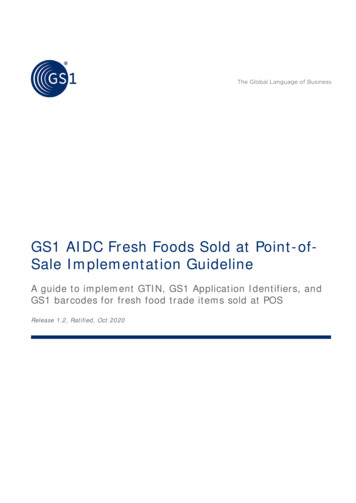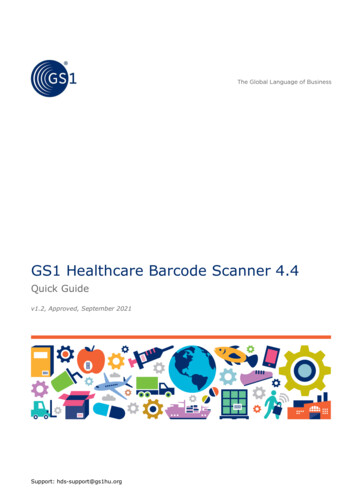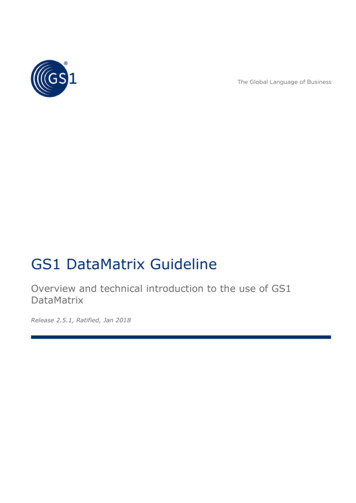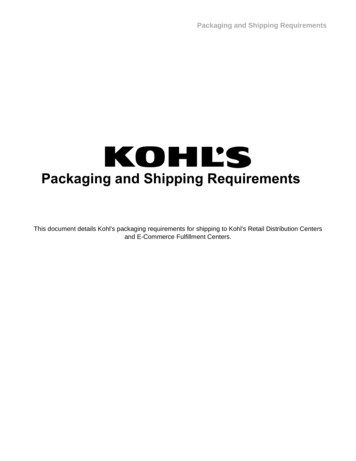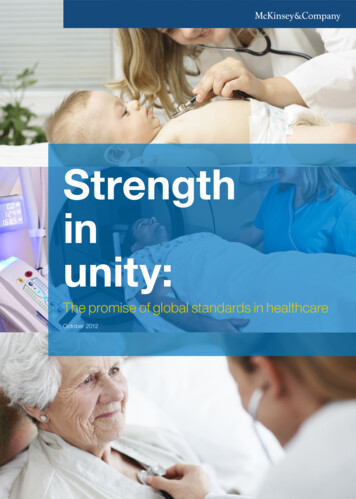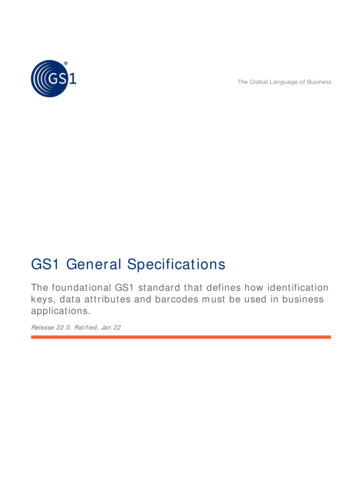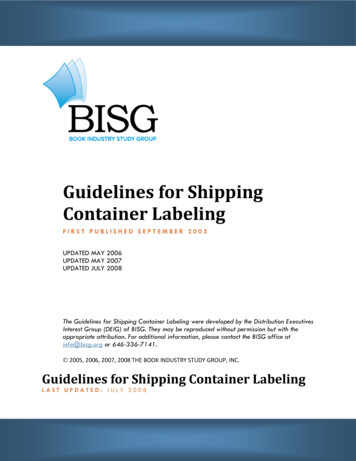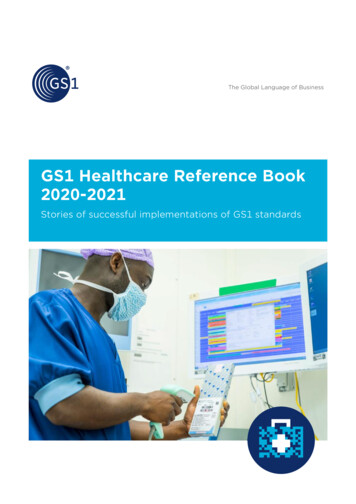
Transcription
The Global Language of BusinessGS1 Healthcare Reference Book2020-2021Stories of successful implementations of GS1 standards
GS1 Healthcare Reference Book 2020-2021THIS DOCUMENT IS PROVIDED “AS IS”WITH NO WARRANTIES WHATSOEVER,INCLUDING ANY WARRANTY OFMERCHANTABILITY, NONINFRINGMENT,FITNESS FOR PARTICULAR PURPOSE, OR‘‘‘‘Safer, moreefficient carestarts with asimple scan.ANY WARRANTY OTHERWISE ARISINGOUT OF THIS DOCUMENT.GS1 disclaims all liability for any damagesarising from use or misuse of thisReference Book, whether special, indirect,consequential, or compensatory damages,and including liability for infringement ofany intellectual property rights, relating touse of information in or reliance upon thisdocument. GS1 retains the right to makechanges to this document at any time,without notice. GS1 makes no warrantyfor the use of this document and assumesno responsibility for any errors which mayappear in the document, nor does it makea commitment to update the informationcontained herein.GS1 and the GS1 logo are registeredtrademarks of GS1 AISBL.23
GS1 Healthcare would like to express its gratitude to thefollowing organisations and experts who contributed to thisedition of the GS1 Healthcare Reference Book: Achê Laboratórios – Márcio Reis Freitas, Brazil Alexion – Giovanny Cruz, Colombia AmerisourceBergen – Ameer Ali, US APX Systems – Fredrik W. Goborg, Norway Cardinal Health – Quentin Dittman, US East Kent Hospitals University NHS Foundation Trust (EKHUFT) – Andy Barrow, UK Franciscan Missionaries of Our Lady Health System (FMOLHS) – Sandi Michel, US Hikma Pharmaceuticals – Khalid Abughoush, Jordan Johnson & Johnson Supply Chain – Tom Jones, US Leeds Teaching Hospitals NHS Trust – Mark Songhurst, UK Lovisenberg Diaconal Hospital – Marit Glende Johnsen, Norway Markhot Ferenc Teaching Hospital – Dr. Robert Gyetvai, Dr. Krisztina Orosz, Dr. JózsefVácity, Hungary McKesson Corporation – Scott Mooney, US Movilitas – Marco Steinkamp, Germany National Center for Global Health and Medicine (NCGM) – Dr. Kengo Miyo, Japan PinkRoccade Healthcare – Maaike Langelaan, Netherlands Radboud University Medical Centre (Radboudumc) – Alex van der Putten,Netherlands Rigshospitalet – Søren Boesgaard, Marianne Kjellow-Andersen, Pernille Preisler, Denmark St. Joseph’s Hospital – Cai-Cing Liao, Su-Chen Lin, Shu-Hui Wang, Chinese Taipei Sydney Local Health District (SLHD) – Matt Mohammadi, Jon Tang, Australia Tallaght University Hospital – John Donovan, Olivia Leigh, Ireland Triple A MedTech Co., Ltd – Kingsley Huang, Chinese TaipeiWe would also like to thank the GS1 Member Organisations(MOs) who helped facilitate the creation of this book: GS1 Brazil – Marcelo Oliveira Sa GS1 Chinese Taipei – Josephine Chen, Nicolas Liou, James Perng GS1 Colombia – Alex Bedoya, Paola Morales, Leonel Pava, Alvaro Sánchez,Katherine Tabares GS1 Denmark – Camilla Aabye Hansen, Anne Aarslev Schmidt GS1 Hungary – Christine Hankó, Zoltán Krázli GS1 Ireland – Amanda Creane, Siobhain Duggan GS1 Japan – Fumi Maekawa, Hiromitsu Takai, Koichi Uemura GS1 Jordan – Mai Ali, Areej Rawashdeh GS1 Netherlands – Esther Peelen, Johanneke Wolters GS1 Norway – Stephen Bølstad GS1 UK – Glen Hodgson, Natasha Smith GS1 US – Salil Joshi, Peter Sturtevant, Shannon SullivanNeed to contact an MO? Visit the GS1 website: www.gs1.org/contact.5
GS1 Healthcare Reference Book 2020-2021What’s insideHealthcare providers and suppliers around the world areexperiencing amazing benefits with GS1 standardsHealthcare providersp.12St. Joseph’s Hospital: Unique DeviceIdentification for better care and patientsafety - Chinese Taipeip.18Cardiac Catheterisation Laboratoryimproves traceability, workflow andreduces items in stock - Denmarkp.24Markhot Ferenc Teaching Hospital:Measuring what’s measurable to improvepatient care and safety - Hungaryp.31Scan4Safety: Giving time back to patientcare at Dublin’s Tallaght UniversityHospital - Irelandp.39Successful implementation of electronichealth record system for the traceabilityof medical materials using unique deviceidentification - Japanp.46Developing the GS1 monitoring tool:A standardised set of patient safetyoutcome measurements Netherlandsp.50Fewer bricks and more clicks result inoptimal medical device inventory atRadboudumc - Netherlandsp.55Lovisenberg Diaconal Hospital achievessignificant efficiency improvements andtraceability for surgical equipment Norwayp.62EPC/RFID: An effective method for realtime asset management - UKp.66How positive patient identification canprovide peace of mind for patients andtheir relatives - UKp.70Fulfiling a vision of digital transformationwith GS1 standards - USUSUSAt FranciscanMissionaries of OurLady Health System,85% of implantsthat come intoits warehouse areidentified with GTINsfor improved inventorymanagement andpatient safety.Results fromAmerisourceBergenand McKessonbarcode assessmentsshowed a significantlyhigher year-over-yearincrease of nearly 52percentage points,compared to the2018 assessment. AtCardinal Health, theimprovement rangedfrom 63.6 to 58.2percentage points.IrelandTallaght UniversityHospital estimates theScan4Safety solutionhas reduced stockwaste by 7,000 in thefirst phase.UKNetherlandsNorwayDenmark East Kent HospitalsUniversity NHSFoundation Trustimplemented GS1standards, givingit real-time assetinformation likelocation details andservice due dates. By using GS1 standardsto identify medicaldevices and share data,the Radboud UniversityMedical Centre isstoring 25% less stockand saving 500,000each year.Lovisenberg DiaconalHospital has automatedits ordering processthat once took up to 2hours a day, but nowtakes only minutes, andwith increased quality.Cardiac CatheterisationLaboratory atRigshospitalet hasreduced stock levelsand freed up timeequivalent to 3 nursepositions.GermanyHungarySince all systemswere based on GS1standards, Bionoricaspent 52% less inimplementation coststo comply with Russianregulation.Markhot FerencTeaching Hospitalprecisely measures itsuse of pharmaceuticalsand medical deviceswith GS1 standards,reducing inventorycosts by 5% the firstyear. By using GS1standards, patientscan be tracked inreal time throughouttheir care journeysat Leeds TeachingHospitals NHS Trust. GS1 MemberOrganisation experts,policy makers andhealthcare workersparticipated in a projectto define a minimum,internationallyappropriate set ofpatient safety outcomemeasurements forevaluating, generatingevidence and improvingthe implementation ofGS1 standards.Suppliersp.80Aché Laboratories successfullyimplements GS1 standards to ensuretraceability – Brazilp.83Traceability: The key for drivingefficiencies in the supply chain Colombiap.87Bionorica ensures compliance withRussian serialisation law before officialdeadline - Germanyp.92Hikma Pharmaceuticals adopts GS1standards for regulatory compliance andtraceability - Jordanp.96Driving Unique Device Identificationcompliance puts focus on patient safety USp.100Barcode readability for Drug SupplyChain Security Act 2023 Interoperability USUSIn support of UDIregulations, Johnson& Johnson companieshave submitted 75,000device records tothe US Food & DrugAdministration’sGlobal UniqueDevice IdentificationDatabase.JapanAt the NationalCenter for Health andMedicine, 340 hoursper year saved torecord medical devicesused in surgery.Chinese TaipeiSt. Joseph’s Hospitalhas improved inventorymanagement, saving50% of the time toprocess an order.ColombiaAlexion has achieved100% traceability ofpharmaceuticals, fromfactory to patientbedside.6BrazilJordanAt Aché Laboratories,180 million drugpackages are labelledwith GS1 DataMatrixbarcodes each year.Hikma Pharmaceuticalshas enhanced brandimage and reputationin target marketsby leading the wayto meet regulatoryrequirements.7
GS1 Healthcare Reference Book 2020-2021An unprecedented year in healthcareAs the collection of case studies were compiled for this 2020-2021 GS1 Healthcare Reference Book,the global healthcare industry was battling the COVID-19 virus.While social-distancing measures have helped to “flatten the curve,” the presence and impact of thecoronavirus will continue to be felt for many months, and even years. The citizens of the world havenever before depended as much on our healthcare systems as now.Researchers are collaborating on vaccinedevelopments and new treatments, healthcaresuppliers are working overtime to provideurgently needed pharmaceuticals and medicaldevices, and healthcare providers are on thefrontlines—millions of “healthcare heroes”caring for patients and saving lives.Throughout this book, read how hospitals areusing GS1 standards to provide better andsafer patient care. Part of England’s NationalHealth Service, East Kent Hospitals UniversityNHS Foundation Trust is providing timely andefficient patient care, since medical equipment,beds and other assets are proactivelymaintained and readily available.With GS1 standards, the FranciscanMissionaries of Our Lady Health System in theUS is using supplier-provided product data toanalyse the cost of patient procedures and theeffectiveness of outcomes. GS1 Netherlandsand other GS1 Member OrganisationsIn Chinese Taipei,St. Joseph’s Hospitalis reducing the timefor processing an orderby 50%.8information across its hospital systems. As aresult, 30% less time is now required to recordmedical devices used in surgery.Progress continues in implementingGS1 standards for the traceability ofmedical devices, surgical equipmentand pharmaceuticals.Japan’s National Center for Global Health andMedicine has successfully identified medicaldevices with GS1 standards and integrated thisWhile the COVID-19 pandemic is challengingthe digital foundation of our global supplychain and national care systems, investmentsin GS1 standards by healthcare suppliers andproviders have strengthened this foundation.Hospitals are operating moreefficiently and delivering enhancedpatient-centric care.At the Lovisenberg Diaconal Hospital inNorway, manual orders that once took up totwo hours every day now take only minuteswith automation supported by GS1 standards.The hospital has full visibility of its many piecesof surgical equipment for safer operations. InHungary, the Markhot Ferenc Teaching Hospitalis using GS1 standards to successfully measureits use of pharmaceuticals and medical devicesfor lower costs, yet highly effective patient care.Suppliers are meeting traceabilityregulatory requirements andstreamlining their delivery ofproducts.Leeds Teaching HospitalsNHS Trust is providingconcerned relatives withreal-time information fortheir patients’ progress.are working with a healthcare consultingorganisation to develop patient safety outcomemeasurements for evaluating and improving theimplementation of GS1 standards in hospitals.Vast improvements in stockmanagement are helping to ensurethat inventory is available, whenneeded.With its progress in stock management,Ireland’s Tallaght University Hospital is givingclinical staff more time to spend with patients.Out-of-stock situations are now virtuallynon-existent at the Cardiac CatheterisationLaboratory in Denmark and the RadboudUniversity Medical Centre in the Netherlands.At Aché Laboratories in Brazil, 180 million or100% of the company’s secondary and tertiarypackages are labelled with GS1 standards.Colombia’s Alexion has successfully completeda pilot of its traceability system that enablesvisibility of pharmaceuticals throughout thesupply chain.Bionorica in Germany completed itsimplementation of pharmaceutical serialisationahead of Russia’s scheduled regulationdeadline. In Jordan, Hikma Pharmaceuticals hassuccessfully implemented a traceability systemfor its complete line of pharmaceuticals—onethat can easily scale across its three globalregions in response to emerging regulations.Johnson & Johnson shares its perspectives anduniversal support of Unique Device Identificationregulations, allowing healthcare providers to useUDI data in their procurement systems, inventorymanagement systems, electronic health recordsystems and implant registries, while upholdingthe highest standards of patient privacy, qualityand compliance.During this time of uncertainty, wecan depend on GS1 standards andeach other.While this time is unprecedented, it’s alsofilled with many opportunities. For morethan 15 years, we have worked together, asAmerisourceBergen,Cardinal Health andMcKesson Pharmaceuticalconducted assessmentsof their suppliers’barcodes, showing aremarkableyear-over-year gain of52 percentage pointsin the presence ofGS1 barcodes to meet theserialisation requirementsof the US Food and DrugAdministration’s DrugSupply Chain SecurityAct.GS1 Healthcare, to digitally transform ourhealthcare supply chain and solve some ofits greatest challenges. Together, we willcontinue to leverage standards, technologyand our innovative spirit to accelerate thistransformation, helping to put the world backon a healthy track.9
GS1 Healthcare Reference Book 2020-2021HealthcareProvidersHealthcare institutions around the world areworking to provide the best possible care fortheir patients, often under pressure to save timeand money. GS1 standards are helping them doall this. Read the case studies over the next fewpages to find out how.1011
GS1 Healthcare Reference Book 2020-2021St. Joseph’s Hospital: Unique Device Identification for better care and patient safetyChinese TaipeiTransforming informationmanagementEarly in 2018, St. Joseph’s Hospital startedits UDI project after visiting the KaohsiungArmed Forces General Hospital (See casestudy in GS1 Healthcare Reference Book2019-2020, page 12.), well-known for itseffective and efficient management of medicaldevices and materials after implementingunique device identification with GS1standards.St. Joseph’s Hospital: Unique DeviceIdentification for better care and patient safetyChallengeApproachSt. Joseph’s Hospital launched a Unique DeviceIdentification (UDI) project that automated itsbusiness and clinical processes by implementing GS1standards to uniquely identify all medical devicesand materials. With this foundation, the hospital wasable to establish a traceability system for implantedmedical devices and collect real-time data abouttheir use and associated inventory levels.Significant improvementsin inventory managementwith automated processes50% 96%of processing time savedper orderSt. Joseph’s (Catholic)Hospital is located inHuwei township, Yunlincounty, Chinese Taipei.It was established byBishop Thomas Niuof the Chiayi diocese in 1955, and two youngand energetic missionaries, Fr. George Massinfrom Belgium and Fr. Anthony Pierrot from theNetherlands, who became the first administratorsof the hospital. Today, the hospital’s mission is toprovide comprehensive medical services to theresidents—especially the poor—of Huwei and itsneighbouring towns.For many years, church-affiliated hospitals “filledthe healthcare gap” by providing services to thepoor who couldn’t afford medical care. Today,even with Chinese Taipei’s policy of nationalhealthcare insurance, St. Joseph’s Hospitalremains focused on serving the needs of society.Driven by the values of “Total Sacrifice, True Loveand Constant Joy,” St. Joseph’s Hospital offersquality medical care to all patients. Its outpatienttreatment services cover 18 clinical specialtiesand sub-specialties, including internal medicine,surgical and other clinical departments. Onaverage, St. Joseph’s Hospital receives more than1,300 outpatients per day.12Increased patientsafety with full producttraceability and auto alertfunctionalityscanning rate after onlytwo monthsAs a private regional hospital, St. Joseph’sHospital is faced with many challenges tomaintain its mission of quality care andcharitable spirit. Throughout 2019, thehospital staff worked with Triple A MedTechCo. Ltd. and GS1 Chinese Taipei, to ensure asuccessful UDI implementation for improvedinventory and information management. Enhance its control of processes andinformation management via theimplementation of the unique deviceidentification of medical devices andmaterials, reducing opportunities for humanerror and increasing patient safety. Improve inventory management for medicaldevices and materials. Establish traceability for implanted medicaldevices used in patients. Integrate all existing systems used by eachof its departments, so that consistentinformation can be shared.In 2019, the hospital received theinternational certification ofISO 9001: 2015. The introductionof GS1 standards for UDIimplementation and the smartmanagement solution weretwo important indicators inthe evaluation of hospitalmanagement’s integrity and quality.This ongoing project will facilitateinformation security and reformprocess management, but will alsopave the way to the ultimate goalof effectively controlling hospitaloperating costs.Overcoming problemsWith 700 caregiversand staff, and 378 beds,St. Joseph’s Hospital iscommitted to the needsof all people of Huwei andsurrounding areas.Su-Chen Lin, Cai-Cing Liao, Shu-Hui Wang &Kingsley HuangLike many hospitals in Chinese Taipei, St. Joseph’sHospital once used paper records, manual processesand no specific methodology to manage its medicaldevices and materials.St. Joseph’s major goal was to achievevisibility and traceability of productinformation throughout its whole supplychain. However, its staff and nurses wereaccustomed to processing records anddocuments, using manual and paper-intensiveprocedures. Due to inconsistent productinformation, this often meant redundant,cross-checking work activities and issuesin operations. Furthermore, the lack ofdisciplined resource management causedwaste and unnecessary costs.With this transformation, St. Joseph’s Hospitalaims to:Many problems occurring in Chinese Taipei’shospitals are often caused by using manualprocedures when maintaining productinformation. This inefficient management ofdata results in issues like: Reduced visibility throughoutcommunications that impacts traceability Human errors and inefficient processes dueto a lack of complete product information Redundant activities for staff Uninformed decision-making caused byunavailable real-time information No real-time alerts about suspiciousproducts or other anomalies Poor communication among differentdepartments caused by of lack ofconsistent product informationEspecially in operating rooms, there is a largenumber of medical items used with manydifferent specifications and types of packagesof the same items. Consignment sales for nonstocked, spare parts also makes control moredifficult. High-risk medical devices with high unitprices often cause high costs for the hospitalif the actual quantity of devices used is notrecorded correctly and matched to suppliers’lists.Another serious situation that St. Joseph’sHospital faces is the decline of surgical patientsover the years. In response, the hospital mustreinforce its strength as a hospital that offersspecialised services, which helps to reduce costsand increase revenue.13
GS1 Healthcare Reference Book 2020-2021St. Joseph’s Hospital: Unique Device Identification for better care and patient safetyAn integrated solution supported byGS1 standardsAll these challenges are related to the lack ofdata transparency. The solution must increasedata visibility and enable the use of UDI datathroughout the hospital’s entire networkof databases. To do this, UDI data must becaptured efficiently and accurately by allsystems—for their individual use, for purposesrequiring interoperability and for updatingelectronic patient records.St. Joseph’s invested significant time, persistenteffort and unwavering passion, workingtogether with GS1 Chinese Taipei. Following aresome of the key success factors: Support from the hospital’s executivemanagement team played an importantrole in facilitating the coordination andcommunication among different staffmembers and departments. It ensured thatall personnel were involved and cooperatedtogether for the same goal, when executingthe plan.The hospital secured support from a thirdparty solution provider and assistancefrom GS1 Chinese Taipei to understandthe feasibility and benefits of UDIimplementation using GS1 standards.The team created awareness, engagementand commitment regarding the UDI conceptin departments where implementationswere taking place. This included deliveringTangible benefits and recognitiontraining, creating a staff working groupand providing ways for staff to suggestimprovements. Workshops and seminars were sponsoredfor the suppliers of medical materials anddevices. The hospital explained the reasonsfor adopting UDI using GS1 standards, andespecially the benefits such as access toaccurate, real-time product data from thehospital’s inventory management system. The implementation of the SmartManagement Cloud solution, developed byTriple A MedTech Co. Ltd., was essential forthe project since it provided the core of thehospital’s information network system.St. Joseph’s Hospital has been working withTriple A MedTech Co. Ltd. to deliver the cloudsolution enabled by UDI and GS1 standards. Thisincludes the use of artificial intelligence (AI) withpatented algorithm and machine/deep learning,to enhance cloud computing capabilities for UDIin clinical medical environments.The solution allows St. Joseph’s to automaticallycomplete the synchronisation of data feedingservices, including the clinical medicalinformation system, supply chain managementsystem, hospital management and logisticssystem.With the assistance of automatic identificationat the front-end of the new service chain,problems associated with manual operationshave been overcome by the smart managementof information solution. This has elevated thequality of medical device management to anew level. St. Joseph’s Hospital won the HighDistinction Award of the “2018 HealthcareQuality Improvement Campaign in ChineseTaipei.” In 2019, the entire hospital passed theinternational certification of ISO 9001: 2015.Quantitative indicators include: The quantity of scanned items has grownfrom 87 to 4314, an increase of nearly 50times. Efficient inventory management hasresulted from the improved accuracy ofreal-time records of 96%. Also, e-statementreports have simplified the reconciliationprocess with suppliers, saving considerableprocessing time of hospital purchase ordersfor medical devices and materials.Figure 2: In the preparation room, product items are all well arranged, especially for those bulk materials in the first-class category. They are easilyidentified by the staff scanning the card with the UDI barcode attached on the drawer. In the left photo, the quantity of products’ usage over timecan be recorded in the information system.Figure 3: Preparing needed items before a surgery has become easier and faster when using the wireless portable reader to scan items’ barcodes.The information system facilitates product data visibility in many processes, increasing administrative efficiency and patient safety. Now, St. Joseph’sHospital has achieved product traceability via effective product management based on GS1 standards for unique device identification.S T J OHO S can Qu an t i t y431436682857 28313143 00450040003500300025002000150010005000STJOHO Scan QuantityFigure 4: In 2019, the quantity of scanned Items per monthincreased from 87 to 4314, nearly 50 times more scans.Figure 5: St. Joseph’s Hospital thanks its UDI project teamthat worked tirelessly to make UDI and traceability a reality.Figure 1: The Cloud Integrative Network of Hospital Information Systems1415
GS1 Healthcare Reference Book 2020-2021St. Joseph’s Hospital: Unique Device Identification for better care and patient safetyEvery stakeholder benefitsSmart box for surgical kitsFurther integration of existing systemsMany medical devices must be unpacked forsterilisation in advance of surgeries. In orderto automatically identify these kits for datacapture, the application of a smart box for eachsurgical kit will be adopted. Before sterilisation,the product information is first stored in thesmart box by scanning the UDI encoded in abarcode on the label of the package. When aspecific smart box is scanned in the operatingroom, the virtual box is matched to the physicalone that will show on the screen, which displaysthe inside tools. The nurse touches the virtualitems on the screen, then the pre-storedproduct info will be automatically input into therecord of usage.For visibility and traceability among informationsystems, St. Joseph’s next phase will use UDIas the sole identifier to integrate the hospital’sclinical and administrative management.Not only can it be used in clinical e-records,accounting aggregation, medical device andmaterial management, the UDI can also providealerts of defective products.Electronic invoice for medical device suppliersSt. Joseph’s Hospital not only applies UDI toclinical medical records, it also integrates thesupplier’s accounting information in the 2020plan. When the medical materials provided bythe supplier are used, the system will generatea unique reconciliation corresponding to theUDI used. This record will become the onlyinformation for invoicing between the hospitaland suppliers. St. Joseph’s Hospital will alsointroduce an electronic invoice exchangesystem, with the key for verification being theUDI.UDI will continue to play a critical role inSt. Joseph’s Hospital. A core strategy of St.Joseph’s Hospital management is to always becompliant with GS1 standards. The hospitalis pushing forward with the concept of UDIdriven administration and management fromthe surgery operating rooms to all existinginformation systems for relevant departmentsand divisions. UDI will help St. Joseph’s Hospitalto efficiently control the inventory of medicaldevices and materials, effectively manage theirsuppliers and source channels, and accuratelyaccelerate purchasing, pricing and financialprocesses.With the implementation of GS1 standardsand UDI, this transformation will lead tosmart hospital management for high-qualityhealthcare services, not only solving challengesfor St. Joseph’s Hospital, but also delivering apromising future for innovative, quality care andpatient safety.Project Head Nurse ShuHui Wang is currently theUDI Project Managing Nurseof Operating Rooms of St.Joseph’s Hospital. Since 2018,she has been responsible forthe initiation of the in-houseUDI project, including planning,monitoring and controlling.She is one of the pioneers whointroduced UDI technology inthe hospital.Cai-Cing LiaoHead Nurse of OperatingRoomSt. Joseph’s HospitalSt. Joseph’s Hospital is planning additional projects for continuous improvements within thehospital and for patient safety.Su-Chen Lin has a doctoratein Industrial Engineering andManagement, specialisingin artificial intelligence anddecision-making analysis. Dr. Linis in charge of administrationmanagement at the hospital. Sheis also the CEO of the CatholicSt. Joseph’s Social WelfareFoundation, investing significanteffort and time to care for eldersin remote areas of Yunlin County.Kingsley Huang, PhDFounder and CEOTriple A MedtTech Co., Ltd.Next stepsAbout the authorsSu-Chen Lin, PhDVice President ofAdministrationSt. Joseph’s Hospitalinformation and traceability of medical devicesare now possible, enhancing quality of care andpatient safety. In short, all stakeholders in thehealthcare supply chain are benefiting from theSt. Joseph’s UDI implementation.Shu-Hui WangProject Head NurseUDI Project ManagerSt. Joseph’s HospitalBy automating processes with the UDIimplementation, healthcare professionals arenow saving a significant amount of time thatthey can now spend on patient care. UsingGS1 standards and simple scans to identifyproducts, visibility of accurate productCai-Cing Liao is currentlyHead Nurse of OperatingRooms of St. Joseph’sHospital. She has beenresponsible for the UDIproject execution andencourages her teammembers to cooperate withother departments to achievethe best results.Kingsley Huang is the founderand CEO of Triple A MedTechCo., Ltd., which helps tointegrate clinical systemswith UDI concepts, usinginnovative solutions to medicalmerchandise management.About the organisationsSt. Joseph’s Hospital is located in Huwei township in Chinese Taipei. Established in 1955 byBishop Thomas Niu and two missionaries, the hospital has 378 beds with approximately 700caregivers and staff. The hospital’s mission is to provide comprehensive medical services tothe residents of Huwei, especially the poor.www.stjoho.org.twTriple A MedTech Co., Ltd. is a young, start-up company with research strengths andworldwide ambitions aimed to provide IoT, blockchain and cloud technologies as a smartsolution to empower the outstanding medical services in major medical institutions. Its GS1standards and UDI-oriented cloud solution offers over 30 hospitals in Chinese Taipei a widerange of clinical services and tracking and clinical assistant diagnosis tools to clinicians andhealthcare providers.www.triplea-medtech.com1617
GS1 Healthcare Reference Book 2020-2021Cardiac Catheterisation Laboratory improves traceability, workflow and reduces items in stockDenmarkNeed for better stock managementIn 2015, Medtronic IHS offered to reviewthe Cardiac Catheterisation Laboratory’sprocedures and measure various factors. Thedepartment received high scores for patientsatisfaction, job satisfaction and IT. However,there was one area that clearly fell short: stockmanagement. Medtronic IHS discovered a highlevel of waste and far too many products onshelves.Cardiac Catheterisation Laboratoryimproves traceability, workflow and reducesitems in stockChallenge“When we closed the door behindus in a procedure room, everythingexuded professionalism. Weprovided excellent treatment, buteverything around us was out ofcontrol.”The hospital department had a non-standardisedmanual process for handling stock inventory. Theprocess was t
Supply Chain Security Act. During this time of uncertainty, we . can depend on GS1 standards and each other. While this time is unprecedented, it's also filled with many opportunities. For more . than 15 years, we have worked together, as GS1 Healthcare, to digitally transform our healthcare supply chain and solve some of its greatest challenges.
